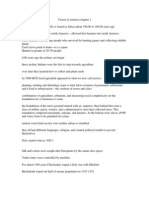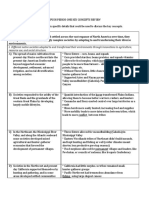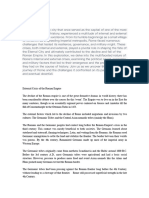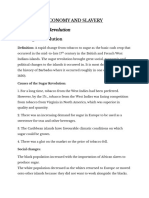Apush
Uploaded by
api-319546486Apush
Uploaded by
api-319546486Period 1: 1491 - 1607
APUSH Review: Key
Concept 1.2
(The Columbian Exchange)
KEY CONCEPT 1.2 AND THE COLUMBIAN
EXCHANGE
The New Curriculum and The Columbian
Exchange
Key Concept 1.2 Contact among Europeans, Native Americans, and
Africans resulted in the Columbian Exchange and significant social,
cultural, and political changes on both sides of the Atlantic Ocean.
Page 26 of the Curriculum framework
The Columbian Exchange revolutionized life in the Americas,
Europe, and Africa.
Big Ideas:
What were positives and negatives of the Columbian Exchange on both
hemispheres?
What were reasons that led to European exploration?
Key Concept 1.2, I
B) Columbian Exchange and its impacts
What
was it?
The exchange of plants, animals, culture, humans, diseases, etc. between the
Americas, Europe, and Africa
Examples
Americas to Europe and Africa: potatoes, maize (corn), tomatoes
Europe to the Americas: wheat, rice, horses, chickens, oxen
The
of goods:
Impact
In Europe and Asia: massive population growth due to new food; increase in wealth;
decrease in feudalism and a rise of capitalism
In Africa: Spanish and Portuguese used Africans from West Africa to be used as
slaves in the Americas
In the Americas: spread of diseases (smallpox and measles), social classes
(Mestizos), horse transformed Native life (made hunting easier), Encomienda system
Key Concept 1.2, I
C) Technology and trade
New technology aided exploration:
Sextant could be used to find exact position on earth
more precise sailing
Caravel, compass, and quadrant improved sailing
efficiency
Economic improvements:
Joint-stock companies used to raise $ for explorations
Used in Jamestown (1607) with the Virginia
Company
Key Concept 1.2, II
Key Concept 1.2, II: The Columbian Exchange and development of the
Spanish Empire in the Western Hemisphere resulted in extensive
demographic, economic, and social changes.
Page 27 of the Curriculum framework
A) Impact of Spanish exploration:
Deadly diseases:
Smallpox, malaria
Killed as many as 90% of Natives in some areas not immune to European diseases
Was also used as a form of germ warfare with the Natives, making it easier for the
Spaniards to conquer them
Introduction of new animals and crops:
Horse transformed Native life on the Great Plains
Crops wheat, rice, and sugar
Key Concept 1.2, II
B) Encomienda System (Check out video in the description)
Native American labor was marshaled (arranged, assembled) on plantations
The goal was to use labor for agriculture and gain precious metal
Eventually, the encomienda system was replaced by African Slave Labor
New Laws of 1542 outlawed the encomienda system
C) Spanish and Portuguese traders acquired slaves from some West
African groups
Slaves were used by the Spanish on plantations and mines
D) Spanish Caste System:
Incorporated Europeans, Africans, Natives
Europeans were at the top (peninsulares and creoles)
Mestizo and mulatos (mixed European and Native, European and African ancestry)
Key Concept 1.2, III
Key Concept 1.2, II: In their interactions, Europeans and Native
Americans asserted divergent worldviews regarding issues such as
religion, gender roles, family, land use, and power.
Page 28 of the Curriculum framework
A) Misunderstandings between each group
Gender many Natives societies were matrilineal
Land Natives did not own individual land
Religion Natives believed in animism, polytheistic; shamans held power
Some useful aspects of each others cultures were eventually adapted:
Natives adapted technology
Europeans adapted agriculture techniques
Key Concept 1.2, III
B) Native resistance to European encroachment and labor:
Natives sought to preserve political, economic, and religious autonomy (independence, self-rule)
Diplomatically and/or militarily
C) Debates over how non-Europeans should be treated:
Many Europeans saw Natives and Africans as savages
Juan de Sepulveda:
Advocated harsh treatment of Natives
Claimed slavery for Natives was justified under Christianity
Bartolome de Las Casas:
Argued that Natives deserved the same treatment as all other men
Played an instrumental role in the ending of the encomienda system
Contributed to the Black Legend
Arguments used to subjugate Africans and Natives?
Racism, religious - spread of Christianity, Natives and Africans were seen as barbaric
You might also like
- Heimler's History - APUSH Live Review Note Guide 2021No ratings yetHeimler's History - APUSH Live Review Note Guide 202152 pages
- Graham Uldrich - WHAP Unit 4 Study GuideNo ratings yetGraham Uldrich - WHAP Unit 4 Study Guide4 pages
- "Colonial America, 1491-1754": Apush Unit One Study GuideNo ratings yet"Colonial America, 1491-1754": Apush Unit One Study Guide6 pages
- W1D2 Period 1 Key Concept Framework Fill-In-The-blank Worksheet 2021No ratings yetW1D2 Period 1 Key Concept Framework Fill-In-The-blank Worksheet 20215 pages
- College Board Concept Outline: Periods 1 To 9No ratings yetCollege Board Concept Outline: Periods 1 To 934 pages
- Labor Slavery and Caste in The Spanish Colonial SystemNo ratings yetLabor Slavery and Caste in The Spanish Colonial System9 pages
- Gale Researcher Guide for: Epidemiological and Environmental Consequences of Global Encounter and ExchangeFrom EverandGale Researcher Guide for: Epidemiological and Environmental Consequences of Global Encounter and ExchangeNo ratings yet
- AmericanYawpChapter1IndigenousAmerica-1No ratings yetAmericanYawpChapter1IndigenousAmerica-122 pages
- AP World History - Modern Exam - Period 2 Notes (1450-1750)No ratings yetAP World History - Modern Exam - Period 2 Notes (1450-1750)4 pages
- European History: A Captivating Guide to the History of Europe, Starting from the Neanderthals Through to the Roman Empire and the End of the Cold WarFrom EverandEuropean History: A Captivating Guide to the History of Europe, Starting from the Neanderthals Through to the Roman Empire and the End of the Cold War5/5 (1)
- The Trail of Tears:The 19th Century Forced Migration of Native AmericansFrom EverandThe Trail of Tears:The 19th Century Forced Migration of Native Americans5/5 (1)
- Lecture 1.1 - The World Before ColumbusNo ratings yetLecture 1.1 - The World Before Columbus14 pages
- Ch.19 Reading Notes: Bea Diaz Period 1.20.13No ratings yetCh.19 Reading Notes: Bea Diaz Period 1.20.133 pages
- Key Content: Created by Mrs. Myers, Chaparral HS, 2016No ratings yetKey Content: Created by Mrs. Myers, Chaparral HS, 20161 page
- The Columbian Exchange Virtual Classroom Lesson PlanNo ratings yetThe Columbian Exchange Virtual Classroom Lesson Plan10 pages
- AP U.S. History Ch. 1 Guided Reading American PageantNo ratings yetAP U.S. History Ch. 1 Guided Reading American Pageant3 pages
- White Slaves, African Masters: Paul BaeplerNo ratings yetWhite Slaves, African Masters: Paul Baepler22 pages
- Foreign, Commonwealth & Development Office - GOV - UKNo ratings yetForeign, Commonwealth & Development Office - GOV - UK14 pages
- Afro Modern: Journeys Through The Black AtlanticNo ratings yetAfro Modern: Journeys Through The Black Atlantic22 pages
- Jewish Slave Trade - Little Known FactsNo ratings yetJewish Slave Trade - Little Known Facts39 pages
- George Washington and Slavery - 18421106No ratings yetGeorge Washington and Slavery - 184211066 pages
- Writing Prompt 4: The Origin of My Name 1No ratings yetWriting Prompt 4: The Origin of My Name 12 pages
- Shakespeare's The Tempest and Post Colonialism83% (6)Shakespeare's The Tempest and Post Colonialism13 pages
- Mamdani - Introduction From Citizen and Subject-Contemporary Africa and The Legacy of Late ColonialismNo ratings yetMamdani - Introduction From Citizen and Subject-Contemporary Africa and The Legacy of Late Colonialism17 pages
- Jeremy Fernando & Kenny PNG - On HappinessNo ratings yetJeremy Fernando & Kenny PNG - On Happiness51 pages
- Ever Feeling One's Twoness: "Double Ideals" and "Double Consciousness" in The Souls of Black Folk - by Ernest Allen JR100% (1)Ever Feeling One's Twoness: "Double Ideals" and "Double Consciousness" in The Souls of Black Folk - by Ernest Allen JR16 pages
- Booker Taliaferro Washington (April 5, 1856No ratings yetBooker Taliaferro Washington (April 5, 18568 pages
- Toba Tek Singh Uncontested PTI Punjab Intra Party Election ResultsNo ratings yetToba Tek Singh Uncontested PTI Punjab Intra Party Election Results58 pages

























































































